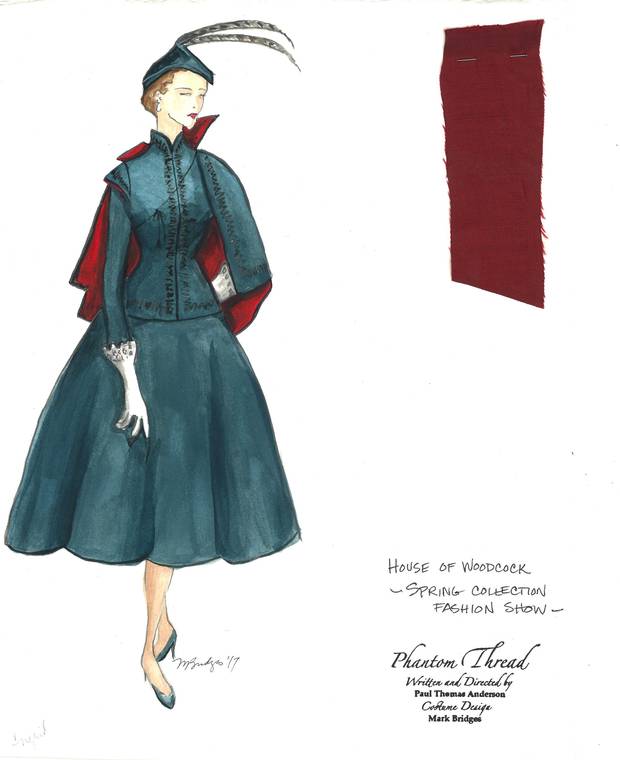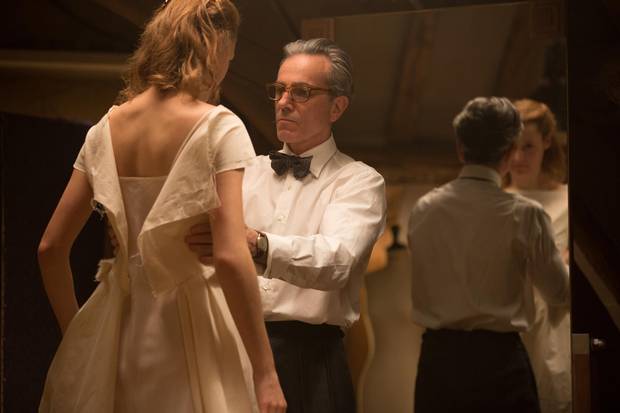For his new film, Phantom Thread, Paul Thomas Anderson ventures to 1952 Mayfair and into the life of fictional London couturier Reynolds Woodcock (Daniel Day-Lewis) and his controlling sister and business partner, Cyril (Lesley Manville), when a young woman named Alma (Vicky Krieps) becomes his lover and muse. In Gothic fashion, the obsessive designer's new relationship dramatically alters the dynamics of the townhouse where they all live and work – the balance of power changes hands as often as Danielle Darrieux's jewellery in one of the film's inspirations, Max Ophuls's The Earrings of Madame de…
Mid-century London couture – the domain of Hardy Amies, Edward Molyneux and Digby Morton – differed from its Parisian counterpart in that it was generally more conservative and modest in scale.
In the film's postwar landscape, Woodcock caters to European high society and American heiresses. To make sure the characters looked the part, a slew of local artisans and heritage brands contributed work and savoir faire to the team lead by Academy Award-winning costume designer Mark Bridges (The Artist, Boogie Nights).
In the summer of 2016, Bridges and Anderson visited the Victoria & Albert Museum archives with curator Cassie Davies-Strodder and examined many garments. Sue Clarke and Joan Emily Brown, a retired fashion teacher with extensive knowledge of its history, and a former Savile Row cutter and sewer, respectively, were not only hired as creative consultants, they also joined the cast to play the workroom's head seamstresses, Nana and Biddy. All this helped Bridges create 50 original garments, including Woodcock's own idiosyncratic wardrobe, by working with bespoke clothing firm Anderson & Sheppard, cobbler George Cleverley and milliner Sophie Lamb. French cutter Cecile Van Dijk consulted for both the costume designer and Day-Lewis in scenes in which the design process was shown.

While expert fashion designers were hired to create the looks for Phantom Thread, Day-Lewis would sketch his own ideas that were incorporated into the designs.
Mark Bridges
Take Woodcock and Alma's first date, when he begins to fit her for a new dress. The resulting gown is a signature piece she wears again later; its shade of puce is part of the designer's distinctive trademark palette. Rich colours and surface embellishments of beading and antique lace are the fictional house codes and much of that came from Day-Lewis himself.
"We had him choose some fabrics, for having a sense of authorship for the House of Woodcock dresses," Bridges explains. "He tends to go for the richer berry-plummy pinks. It's interesting because if you look at the history of purple it's always associated with royalty, or magic, or mysticism. And then when it gets a pinker purple it's eroticism, seduction, things like that. A few layers down those pinky-plums and purples actually have a bit of resonance."
An important gown for client Countess Henrietta Harding began as "a little pencil sketch that Daniel had done in that meeting when we got together to decide on the House of Woodcock look." Bridges made adjustments enough so that the early idea became a wearable garment. "It keeps it interesting that he has a hand in that for a role that he's playing as a designer." The courtly dress has a formal, ceremonial feeling that if anything, Bridges says, "would be similar to [Royal Family couturier] Norman Hartnell, as far as making a gown for a particular occasion. It seems he did that quite a bit for the Queen."

The House of Woodcock look has a ceremonial, formal feeling befitting royalty, costume designer Mark Bridge says.
Mark Bridges
Phantom Thread embroiders other fashionable facts with fiction. In spirit and in design, Woodcock himself is a composite of details about the city's most famous and most forgotten designers. Flourishes like secrets and mementos sewn into hems come from the urban myth that Alexander McQueen inserted personal messages inside the lining of suits when he worked on Savile Row, for example. And when Harding says that Woodcock's dresses give her courage, she's borrowing the line of devoted Cristobal Balenciaga client Bunny Mellon (whose every stitch down to her gardening togs was designed by the couturier). That detail, and elements of Woodcock's tortured genius and imperious artistic temperament, come from The Master of Us All. Everyone on the production read Mary Blume's biography of Balenciaga that charts the internal culture of his Parisian maison through interviews with his long-time vendeuse Florette Chelot (Bridges even originally wanted Cyril to be in navy, just as Balenciaga's were, but they compromised on charcoal grey).
Some of the elaborately panelled and seamed bodice evening gowns call to mind Charles James, another poetic mid-century designer whose house closed in those changing times, and several looks in the spring House of Woodcock collection sequence are nods to other overlooked London couturiers. "There's one that has a cape and a hat with a feather that's actually a vague homage to the house of Charles Creed at the time, who liked passementerie and braids and things like capelets, with a vague military influence. The idea of the big long feather was Daniel's," Bridges adds, "and I think it works dramatically. And John Cavanagh was a little bit of an influence in one of the tailored suits too."
At one point Alma, while working as a house model, has the temerity to criticize her lover's choice of fabric. As Woodcock rails against the word "chic" toward the end of the film, there's the hint that he may soon share the obsolete fate of the designers referenced in the costume design, Bridges admits. "He learned his trade from his mother, in the early part of the 20th century. But it's the 1950s now and he's still using those materials and techniques from the turn of the century and it's about to become a brand new world of fashion with Dior and Saint Laurent and [Balenciaga's] sack. It is just about to leave him behind."
Visit tgam.ca/newsletters to sign up for the Globe Style e-newsletter, your weekly digital guide to the players and trends influencing fashion, design and entertaining, plus shopping tips and inspiration for living well. And follow Globe Style on Instagram @globestyle.
